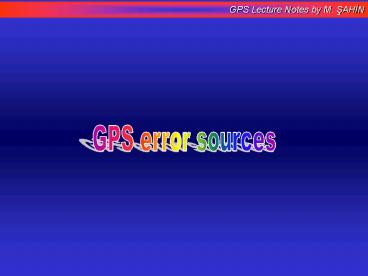GPS - PowerPoint PPT Presentation
1 / 18
Title:
GPS
Description:
GDOP, clock error, orbit error & SA (removed on May 2, 2000) ... Water Vapour Radiometer (WVR) can be used to model the wet. component. The cost is US$ 100 000. ... – PowerPoint PPT presentation
Number of Views:60
Avg rating:3.0/5.0
Title: GPS
1
GPS error sources
2
Error sources in GPS
- Satellite dependent errors
- GDOP, clock error, orbit error SA (removed on
May 2, 2000) - Propagation dependent errors
- ionosphere, troposphere, multipath
- Receiver dependent errors
- receiver clock error, antenna phase centre
variation, - measurement uncertainty
3
GDOP (Geometric Dilution of Precision)
- GDOP is the measure of goodness of the
satellite position in space - the good GDOP position
- 3 satellites are at 120 degrees from the
location - a fourth satellite is directly over head
2
4
1
3
120o
120o
1-2 1-3 2-3
120 degrees
120o
4
Clock errors (satellite receiver)
- signal travel time from satellite to receiver
is - approximately 0.067 seconds
- an error of 1 micro second (0.000001 seconds)
causes - a range error of about 300 metres
5
Satellite clock error
- caused by inability of satellite oscillator
(clock) to maintain the GPS time - GPS satellites use high stability atomic clocks
(caesium or rubidium), which - result in satellite clock errors which are
smaller than receivers because - they use cheaper crystal oscillators
(clocks). - The magnitude is of the order of 10-14 seconds.
- Satellite clock errors are broadcasted by the
navigation message - So, the satellite clock errors can be modelled
using the broadcast satellite - clock corrections
- Can be removed using the SINGLE DIFFENRENCING!.
6
Receiver clock errors
- Receivers use inexpensive quartz crystal
source. The reason is to - keep the receiver costs to an affordable
level - The receiver clock error is larger than the
satellite clock errors - If the receiver clock is in error, the error
will affect all the - measurements to all satellites. The receiver
clock error is identical - for all satellites observed simultaneously.
- To determine the 3D position, three unbiased
satellites - measurements are required. To account for
- the receiver clock error, an additional
- satellite is observed
7
Errors in satellite orbit
- the force of gravity causes the satellite to
move at - approximately four kilometres per second.
- The orbit is described with 6 Keplerian
elements - (1) semi-major axis,
- (2) eccentricity,
- (3) inclination,
- (4) right ascension of the ascending node,
- (5) argument of perigee,
- (6) true, or mean, or eccentric anomaly.
8
Errors in satellite orbit
- There are effects that degrade the accuracy of
the satellite orbit - (see next page)
- The broadcast orbit is calculated by the Master
Control Station. - The parameters of each satellite are uploaded
to the satellites for - use in the future. So the it is predicted
orbit. - For real-time applications, the broadcast orbit
is used. - Alternatively, for post processing
applications, precise orbit - can be used.
9
Errors in satellite orbit
Moon
Sun
Earth-reflected radiation pressure of Sun
Asmospheric drag
Earth Ocean Loading
Direct radiation pressure of Sun
Non-spehericity of Earth
Earth
10
- SA (Selective availability), removed on May 2,
2000 - Error on satellite clocks
- Error on satellite coordinates
11
Atmospheric errors
20 000 km
200 km
Ionosfer
Tropospher
50 km
Cloud
Earth
12
Atmospheric errors
- The speed of light is computed based on a
propagation through - a vacuum (299 792 458 m/second).
- Propagation through the atmosphere causes
changes the speed - of the satellite signal.
- In order to control the atmospheric errors, an
elevation mask - is adopted during data collection and
processing - (eg. 10-15 degrees)
13
Tropospheric errors
- Troposhere causes a delay on code carrier
measurements - which may reach about 2.5 metres at the
zenith 30 meters at - the horizon.
- The delay varies with temperature, pressure,
humidity the - height of the receiver.
- The error has two parts dry wet components
- Dry component can be modelled with the surface
measurements - However, it is difficult to model the wet
component in this way - due to the difficulties in estimating water
vapour content. - Water Vapour Radiometer (WVR) can be used to
model the wet - component. The cost is US 100 000.
14
Tropospheric errors
- The reference and rover receivers should have
approximately - the same altitudes (eg. it is impossible in
areal photogrammetry) - The models used in tropospheric modeling are
- Hopfield (most commonly used)
- Black
- Saastamoinen
- Modified Hopfield
15
Ionospheric errors
- Free thermal electrons are present in the
ionosphere. The number - of free electrons is defined by the Total
Electron Content (TEC). - The TEC varies with a number of factors
including time of day, - location, season, and also the period of the
11 year sunspot cycle. - Ionospheric errors can be eliminated using dual
frequency - receivers (L1 L2). The resulting phase (L3)
is called - ionosphere-free linear combination.
- For single frequency receivers, the measurements
should be - modelled and the receiver separations should
be kept as sort as - possible.
16
Multipathing errors
- careful site selection
- increase observation sessions
- use new generation receivers
17
Antenna Phase Center Variation
18
Measurement uncertainty
- Any measurement made with any electronic
instrument has a - randam measurement error (or noise).
- In GPS case, L1 L2 are subject to noise.
- In most static surveying, linear combinations of
L1 L2 are - generated to eliminate the random noise
(wide-lane, narrow-lane, - ionospheric-free combinations)































